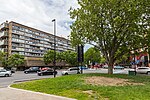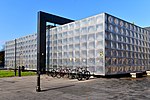London College of Communication

The London College of Communication is a constituent college of the University of the Arts London. It specialises in media-related subjects including advertising, animation, film, graphic design, photography and sound arts. It has approximately 5000 students, and offers about sixty courses at foundation, undergraduate and postgraduate level. It is organised in three schools: media, design and screen; all are housed in a single building in Elephant and Castle. It received its present name in 2003; it was previously the London School of Printing and Graphic Arts, then the London College of Printing, and briefly the London College of Printing and Distributive Trades.
Excerpt from the Wikipedia article London College of Communication (License: CC BY-SA 3.0, Authors, Images).London College of Communication
Elephant and Castle, London Elephant and Castle (London Borough of Southwark)
Geographical coordinates (GPS) Address Phone number Website External links Nearby Places Show on map
Geographical coordinates (GPS)
| Latitude | Longitude |
|---|---|
| N 51.494680555556 ° | E -0.10188055555556 ° |
Address
London College of Communication
Elephant and Castle
SE1 6SB London, Elephant and Castle (London Borough of Southwark)
England, United Kingdom
Open on Google Maps








